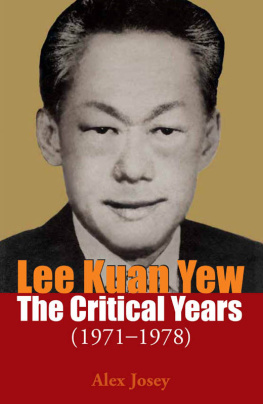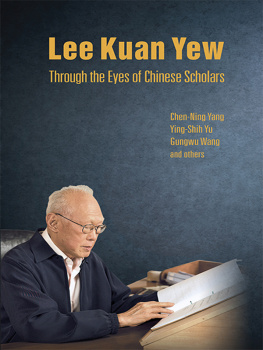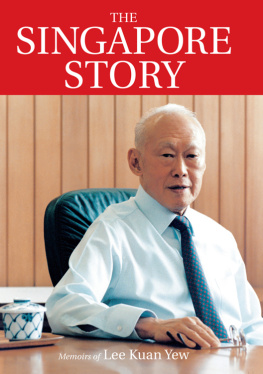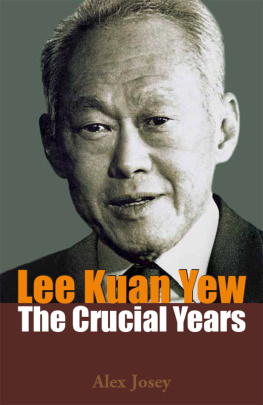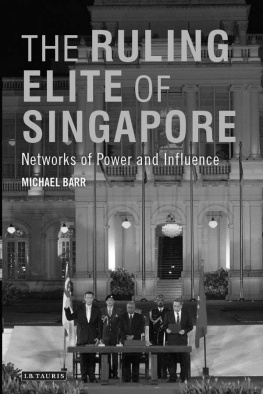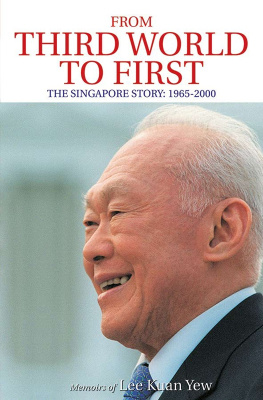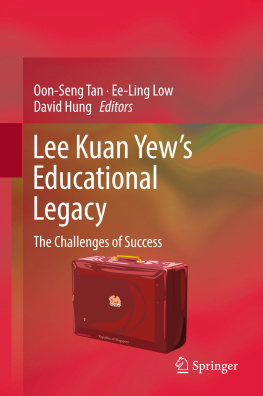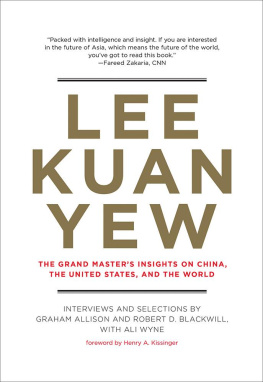LEE KUAN YEW
THE MAN AND HIS IDEAS

LEE KUAN YEW
THE MAN AND HIS IDEAS
Han Fook Kwang
Warren Fernandez
Sumiko Tan

1998 Times Editions Pte Ltd
The Straits Times Press
This paperback edition published 2015 by
Marshall Cavendish Editions
An imprint of Marshall Cavendish International
Times Centre
1 New Industrial Road
Singapore 536196
and
The Straits Times Press
a member of Singapore Press Holdings
1000 Toa Payoh North
Singapore 318994
All rights reserved
No part of this publication may be reproduced, stored in a retrieval system or transmitted, in any form or by any means, electronic, mechanical, photocopying, recording or otherwise, without the prior permission of the copyright owner. Requests for permission should be addressed to the Publisher, Marshall Cavendish International (Asia) Private Limited, 1 New Industrial Road, Singapore 536196. Tel: (65) 6213 9300, fax: (65) 6285 4871. E-mail: .
Website: www.marshallcavendish.com/genref
The publisher makes no representation or warranties with respect to the contents of this book, and specifically disclaims any implied warranties or merchantability or fitness for any particular purpose, and shall in no event be liable for any loss of profit or any other commercial damage, including but not limited to special, incidental, consequential, or other damages.
Other Marshall Cavendish Offices
Marshall Cavendish Corporation. 99 White Plains Road, Tarrytown NY 10591-9001, USA Marshall Cavendish International (Thailand) Co Ltd. 253 Asoke, 12th Flr, Sukhumvit 21 Road, Klongtoey Nua, Wattana, Bangkok 10110, Thailand Marshall Cavendish (Malaysia) Sdn Bhd, Times Subang, Lot 46, Subang Hi-Tech Industrial Park, Batu Tiga, 40000 Shah Alam, Selangor Darul Ehsan, Malaysia
National Library Board, Singapore Cataloguing-in-Publication Data
Han, Fook Kwang, author.
Lee Kuan Yew : the man and his ideas / Han Fook Kwang, Warren Fernandez, Sumiko Tan. Singapore : Marshall Cavendish Editions : The Straits Times Press, 2015.
pages cm
Originally published: Singapore : Times Editions Pte Ltd : The Straits Times Press, 1998.
eISBN : 978 981 4677 68 4
Lee, Kuan Yew, 1923-2015. 2. Singapore Politics and government 1965-1990. 3. Prime ministers Singapore Biography. I. Fernandez, Warren, author. II. Tan, Sumiko, author. III. Title.
DS610.73.L45 |
959.5705092 -- dc23 | OCN905843223 |
Printed in Singapore by Craft Print International Ltd
Acknowledgements
W e are grateful to Mr Lee Kuan Yew for his support of the project and the many hours he spent with us in interviews for the book, and for his advice and encouragement throughout. Our thanks, too, to Mrs Lee for the use of photographs from the family album.
We would like to thank the Executive Chairman of Singapore Press Holdings, Mr Lim Kim San, and the Editor-in-chief of its English and Malay newspapers division, Mr Cheong Yip Seng, for their support of the project.
Several people helped in the research and in reading the drafts, especially Straits Times journalist Pang Gek Choo, who was invaluable in both.
Our thanks are due also to The Straits Times, the National Archives of Singapore, Lianhe Zaobao and the Ministry of Information and the Arts for the use of their resources.

Contents
IN HIS OWN WORDS:
SELECTED SPEECHES AND INTERVIEWS


Introduction
W hen Lee Kuan Yew wanted Singapore to become a garden city, to soften the harshness of life in one of the worlds most densely populated countries, he did not write a memorandum to the environment minister or to the head of the agency responsible for parks and trees. He did not form a committee nor seek outside help to hire the best landscapists money could buy. For one thing, in the 1960s, when he was thinking of these matters, money was in short supply. In fact, having been unceremoniously booted out of Malaysia, the countrys economic survival was hanging in the balance. For another, there was no environment minister to speak of then, so low down in the list of priorities were these matters. When jobs had to be created and communists fought in the streets, only the birds were interested in flowers and trees.
But Lee was interested. And he became personally involved in the project of transforming Singapore from just concrete and steel to concrete, steel, trees, shrubs, flowers and parks. He would become personally knowledgeable about soil and vegetation, trees and drainage, climate and fertilisers. And he surveyed the world for ideas, taking advantage of his travels abroad to look out for them. In France, for example, he discovered that the broad tree-lined boulevards were possible because a drainage system had been built below the pavements. Around each tree was a metal grating through which surface water flowed into the underground system.
The problem of the grass in Singapore, which everyone could see in the bald, yellow football fields, needed a nationwide solution. When he saw beautiful rolling meadows in New Zealand he was moved to ask for the services of two experts from the country under the Colombo Plan technical assistance scheme. Lee was told that Singapore did not have a grassland climate in which rain fell gently from the skies. Instead, being part of an equatorial region, it experienced torrential rainfall that would wash off the topsoil and with it the vital nutrients necessary for strong plant growth. In an equatorial forest, with tall big trees forming a canopy, the rain water drips down. But in Singapore, where the trees had been chopped down, it would all come down in a big wash.
But Lee was not one to let climate get in the way. Fertilisers would replenish the soil, and so began the task of making compost from rubbish dumps, adding calcium, and lime where the ground was too acidic.
Years later, when economic survival was no longer an issue and Singapores success was acknowledged worldwide, he was still working at it to make the garden city possible. When expressways and flyovers sprouted all over the island, he had officials look for plants which could survive below the flyovers where the sun seldom shone. And instead of having to water these plants regularly, which was costly, he got them to devise a way to channel water from the roads, after filtering it to get rid of the oil and grime from the traffic above.
The constant search for solutions would not end. When development intensified even further and the roads and flyovers became broader still, shutting out the light completely from the plants below, he did not give up. The road was split into two so there would be a gap in the middle with enough space for sunshine and rain to seep through and greenery and vegetation to thrive below. I sent them on missions all along the Equator and the tropical, subtropical zones, looking for new types of trees, plants, creepers and so on. From Africa, the Caribbean, Latin, Middle, Central America, weve come back with new plants. Its a very small sum. But if you get the place greened up, if you get all those creepers up, you take away the heat, youll have a different city, he said.
Next page


